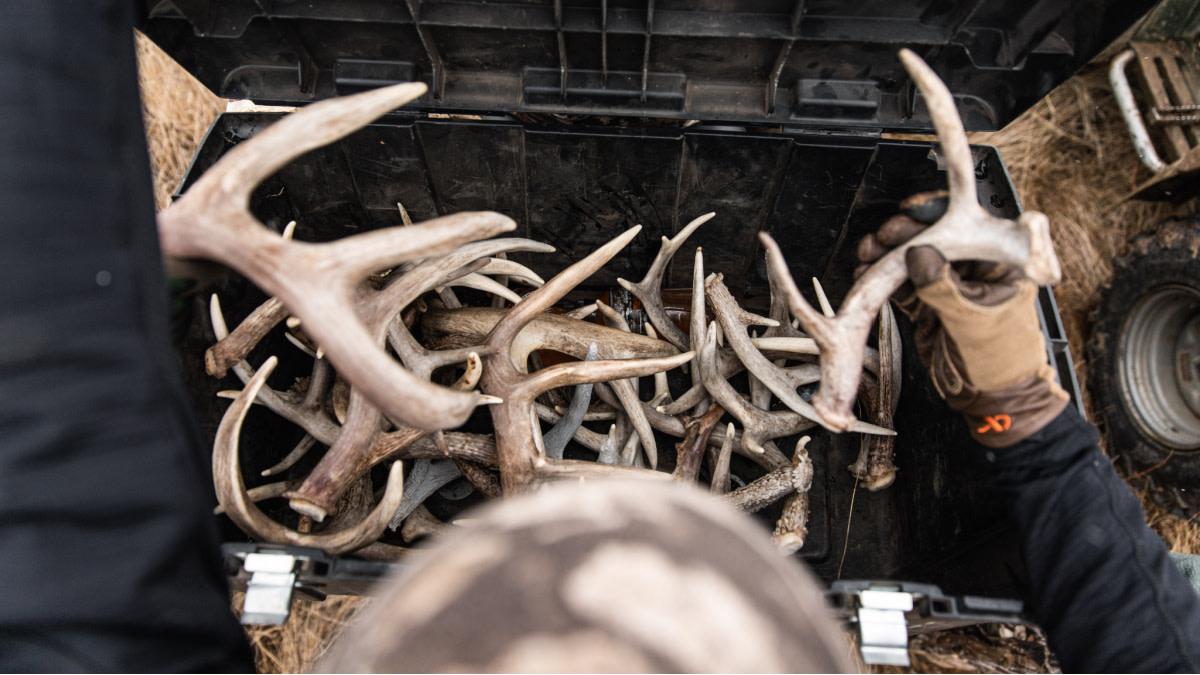
The basics of shed hunting are well known, but the devil is in the details.
Efficient use of time is the golden rule of shed hunting, so let’s not beat around the bush. Here are four simple tricks that will help you gain shed hunting success.
Scout Like it’s Hunting Season
The best DIY whitetail hunters I’ve interviewed on the Wired to Hunt podcast all prioritize extensive scouting. This emphasis also applies to shed hunting.
If you don’t have 2,000 acres stocked with food plots and standing cornfields to keep bucks and their sheds right where you want them, your best option is to scour the region you hunt to find where the bucks naturally want to be.
Brennen Nading, of The Breaking Point TV, recommends scouting for sheds with two focuses in mind. First, you need to determine where deer are spending their time during late winter. It’s important to note, this is not always the same as where they were during hunting season. Scouting provides a starting point for where to search. The second focus is determining when antlers start dropping.
“Know when to go by monitoring the deer in your area,” Nading said. “Don’t bust them out until you’re sure most of the bucks have dropped.”
Scouting for winter activity and antler drop is best achieved via trail camera observations, long-distance glassing of crop fields, or occasional on-foot recon. The trick is to gain necessary information without making such a ruckus as to spook bucks out of your area before they drop their antlers.
Try New Positions
The average shed hunter burns through the woods covering as much ground as possible. As Tony Peterson covered in a recent article about why you might suck at shed hunting, speed walking is a common trait among unsuccessful antler pickers.
The best shed hunters know to only burn across certain low-odds areas, while slowing way down in more likely locations. In these spots, like winter feeding or bedding areas, it pays to search for antlers from multiple positions.
When walking in one consistent direction it’s easy to miss an antler that might be hidden behind a bush, log, or tuft of grass. The trick to seeing these hard-to-spot antlers is to occasionally stop and look around from different positions. Stand up on a log, squat down low, and turn around to scan the area behind you. Do this repeatedly when in the most “sheddy” looking locations and you’ll be surprised by what you discover.
Always Pack Glass
“Never walk without glass,” Nading said. “Binoculars are going to save you a ton of wasted steps and help you find more bone.”
I couldn’t agree more. I’m a strong believer in confirming every potential antler sighting with a closer look. Whether it be a distant glint of white in tall grass or a curved silhouette on a hillside, I’d rather check it and be wrong then ignore it and pass by an antler. If you can do this with binoculars rather than on foot, it speeds things up considerably.
No matter what, if I have any inkling that a shape in the distance might be an antler, I’m checking with my binos. No ifs, ands, or buts.
Train Your Eye
The human eye is tuned to pick up patterns amidst the visual noise of a busy world. An experienced hunter’s eye, for example, is trained to pick out the shape of a deer’s ear or the flick of a white tail from the clutter of brushy thicket. This same pattern recognition is important to the shed hunter’s ability to spot antlers.
The more you search for and find antlers, the more your brain and eyes become attuned to the necessary cues. But if you’re not frequently finding sheds, it’s easy to lapse into a state of atrophy that can lead to overlooked bone. The solution to this problem is to proactively provide an occasional reminder to your subconscious self of what it needs to be searching for.
To do this on your next shed hunt, bring along a small antler from home. When you hit an especially long dry spell, toss it out in front of you and practice looking for it from different angles. This simple visual exercise can help train your brain to subconsciously pick out the shape of a tine or shine of ivory in the distance that you might have otherwise missed.
Shed hunting takes determination, endurance, and a good attitude. Add these four tricks to that mix and this shed hunting season could be your very best yet.
Feature image via Captured Creative.





Conversation